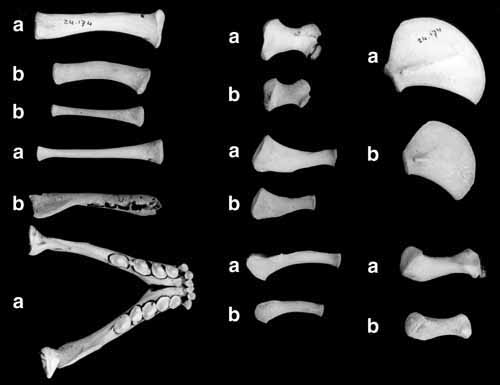 |
|
|
 |
||
Peter J.H. van Bree1 & Aliki Panou2 The bones were all in the faeces, not under it and not arranged as might be expected if the animal had died in situ. Thus it follows that, most probably, a monk seal ate the aborted fetus or the stillborn young and that the bones of the young left the body together with the faeces. This would mean that monk seals, like some other mammals, eat dead young, a behaviour of the species not known until now. Conceivably, it might also be a case of cannibalism as has been described in grey seals (Kovacs et al. 1996). Other explanations are possible. Given that so little is known about the general biology of monk seals, however, and that so few observations have been made concerning its behaviour, especially during parturition, this note is published to draw attention to this curious phenomenon. The bones of the monk seal fetus or still-born young could be identified owing to the fact that the Amsterdam Zoological Museum received in December 1989 the body of a very young female monk seal. This abandoned seal was found alive on the island of Ikaria, Dodecanese, Greece. It was brought on 21 October 1988 to the Seal Rehabilitation and Research Centre at Pieterburen, the Netherlands, where two pup monk seals had previously been reared successfully (’t Hart & Vedder 1990). Unfortunately, the animal died on 13 December 1988 due to a torsio omentum mesentarialis. When the young seal arrived in the Netherlands it weighed 13 kg and at its death 19.5 kg. At the time of its death it had a total length of 91.8 cm, a tail length of 11.8 cm and a hind foot length of 21.0 cm. At arrival at Pieterburen it had already lost its lanugo and at death the front teeth just cut the gums. These facts suggest the animal probably was born at the beginning of September 1988. The bones in the faeces are very similar to the bones of this very young monk seal present in the Zoological Museum of Amsterdam (reg. nr. ZMA 24.174); see fig. 1. Although almost nothing is known about the duration of pregnancy in monk seals and of the development of the fetus in the species, the authors estimate, in view of the sizes of the bones and the development of the mandible, that the fetus was aborted shortly before the normal birth date. Bareham, J.R. & A. Furreddu. 1975. Observations on the use of grottos by Mediterranean Monk Seals (Monachus monachus). J. Zool. London, 175, 291-298. Hart, L. ‘t & L. Vedder. 1990. The rehabilitation of two newborn Mediterranean Monk Seals (Monachus monachus) in the Seal Rehabilitation and Research Centre (SRRC) at Pieterburen, the Netherlands, 17 unnumbered pages. Zeehondencrèche, Pieterburen. Jacobs, J. & A. Panou. 1988. Conservation of the Mediterranean Monk Seal, Monachus monachus, in Kefalonia, Ithaca and Lefkade Isl., Ionian Sea, Greece. Report Inst. of Zoology, Univ. of Munich, 1-221. Panou, A. & E.H. Ries. 1985. Preliminary report on some data on the biology and behaviour of the Monk Seal, Monachus monachus. Rapp. Comm. Int. Mer Med., 29 (8): 173-174. Kovacs, K.M., C. Lydersen & M. Hammill. 1996. Grey Seal Cannibalism. Marine Mammal Science, 12 (1): 161.
1 Zoological Museum, University of Amsterdam, P.O. Box 94766, NL-1090 GT Amsterdam, the Netherlands
2 Archipelagos – Marine and coastal management, Georg. Vergoti Ave. 61, GR-28100 Argostoli, Cephallonia, Greece
On 1 August 1984, the second author found in a cave, situated about 3 metres up the beach on the island of Piperi, Northern Sporades, Greece, the faeces (less than one day old) of a monk seal, Monachus monachus (Hermann, 1779). Droppings of monk seals are often found in caves (Bareham & Furredu 1975, Panou & Ries 1985, Jacobs & Panou 1988), but this time mammal bones were found in the faeces. The bones were collected, cleaned and the larger ones were sent to the first author for identification. They turned out to be the bones of a monk seal fetus or perhaps a still-born pup.

Fig. 1. The larger bones of a monk seal of about three months old (a) compared to the bones found in the faeces of an adult monk seal on the island of Piperi, Greece (b). The length of the mandible of the first specimen (ZMA 24.174) is 119 mm. Photograph by Hans van Brandwijk.
References
Copyright © 2000 Peter J.H. van Bree, Aliki Panou, The Monachus Guardian. All Rights Reserved